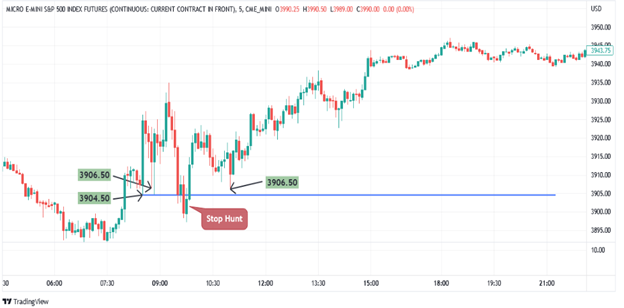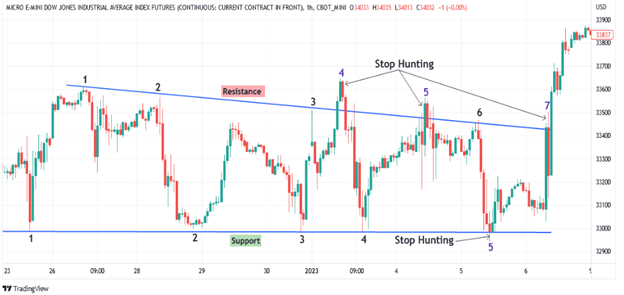What is Stop-Loss Hunting?
Stop loss hunting (or “stop hunting” for short) is a type of trading strategy that aims to profit by deliberately triggering other traders’ stop losses.
Certainly, this is something that you should watch out for; but is it something that you can also attempt, given the right strategy?
Here’s how it works:
Trader A buys an asset at $12 and places a stop-loss at $10. Trader B suspects that this is what another trader (Trader A) is doing and seeks to exploit it. So, Trader B places a sell stop around $10. If the market goes in Trader B’s directions, it then hits the $10 level and Trader A’s stop loss (along with those of others who placed a stop at that level) gets triggered, causing prices to rapidly fall below $10. Trader B takes the position and then quickly closes the position at a profit.
Is Stop Hunting Unethical?
Some traders view it as unethical or predatory. When large institutions are engaging in this activity, certain regulatory bodies (like the CFTC) have rules in place to prohibit it. When institutional traders place trades, they often have ample capital to move or manipulate markets. Not so with small retail traders.
The fact remains that certain market levels may be bunching-up stop-loss orders, and these levels may present opportunities. Unlike the institutional trader, you wouldn’t be moving markets. Instead, you’d be taking advantage of the flow of the market should a large amount of stop-losses be triggered by market movements.
How Do You Hunt for Stop-Losses?
The concept behind stop hunting is pretty simple. Here are four general ways traders may attempt it:
- Key Technical Levels: Attempt to figure out where stop-losses may be concentrated based on support and resistance or key chart pattern levels.
- Order Flow: Look at order volume to determine where stops may be concentrated. Large orders indicate the possibility of large stop-loss accumulation.
- Depth of Market Data (DOM): For ultra short-term trades, DOM can help you figure where stop losses are likely accumulating (most platforms offer DOM data).
- Sentiment and News Analysis: For stop concentrations among investors, monitor the news and any market-moving economic release. If a news release garners significant response from the markets, try to determine where these larger investors are placing their stop-losses.
Is Stop Hunting Risky?
Yes, it can certainly be very risky, especially if you’re trading large positions to try to make significant returns on a few ticks or points. Plus, you’re trying to predict market behavior; a very difficult task.
But if you are interested in stop hunting, we’ll present a few strategies to hunt for stop losses as well as strategies to protect yourself from other stop hunters.
Stop Hunting with the Pros
Stop hunting is a technique adopted by strong investment players to remove the weak players from the market by pushing the price of an asset to such a level where the majority of the players have placed their stop loss. Most retail traders become discouraged by this, who are forced out of their positions, only to see the market reverse and trend in the direction they had initially analyzed.
Strong players such as hedge funds, institutions, etc. need liquidity in order to efficiently get in and get out of the market, so they routinely scan the market for areas of liquidity to get their order filled. These strong players are very familiar with areas such as support and resistance, chart patterns, or the ill-advised level of 10% from the entry price. Whereas, strong players in combination may temporarily move the markets in an attempt to find the needed liquidity.

Figure 1.1 Micro E Mini S&P 500 Index Futures 5 Min Chart of 10th January 2023
For example, if we observe the Micro E Mini S&P 500 chart, we see that prices took support between $3904.50 and $3906.50 a couple of times. Traders might go long and place a stop below the support level around $3904 – $3900. After a few bars of trading activity, prices rallied and retraced back to its support level of 3904.5. Following this, another group of traders go long and place their stop loss orders in the same $3904 – $3900 price zone.
These strong players enter the market and push the price down below 3900 level triggering all the stop loss orders. This forces many retail and individual traders out of the market, and the strong players who were having a short position would now buy back the asset, which would result in a buying pressure on the asset. The market finally rallies in the direction the trader originally anticipated.
What are some tips to take advantage of Stop-Hunting?
TIP ONE: Mean Reversion Strategy
- Look for support and resistance levels within a defined trading range.
- Wait for the breakout below the support level or above the resistance level.
- Once the breakout happens look for a reversal candle, which brings the price back in the trading range. Enter into a sell trade when the following candle closes below the reversal candle, and enter a buy trade if the following candle closes above the reversal candle [See numbered arrows below]
- Place the stop loss above the reversal candle high.
- The target is placed at the opposite side of the range.

Figure 1.1 Micro E Mini Dow Jones Industrial Average Index Futures hourly chart 23rd December 2022 to 8th January 2023
In the above figure, points no. 4 and 5 are at resistance level. Point no. 5 is at a support level indicating stop hunting. Prices broke the support and resistance levels and are seen to reverse back in the trading range. Point no. 7 is at the resistance level, also indicating stop hunting, but the candle that followed after the reversal candle did not make a lower low, so the trade never materialized.
TIP TWO: Contrarian Approach
It is a learned behavior that prices would turn back up from support levels and turn back down from resistance levels. So instead of going with the crowd, doing the opposite will help a trader follow smart money and in the process may be profitable, where most traders stop losses that are bound to be triggered.
By building a framework for joining the strong players, a trader can take advantage of these moves and be on the right side of the market.
Now let’s look at stop hunting from the opposite side—those who hold stops that are “hunted.”
Protecting Your Position From Stop Hunters
Set your stop loss at a level where it invalidates your trading setup.
Whenever a trade is entered it is probably based on a technical pattern like breakout, triangles, channels etc. So it would make sense if a stop loss is placed at a level where the technical pattern is invalidated. For instance if you are trading a breakout, then your stop loss should be at a level where if the price reaches it, the breakout has failed. This will ensure that you are not stopped out too early.
Use of ATR when placing stop losses
Let us revisit the earlier example – instead of keeping the stop loss a few points away from the support level, one can use the ATR to define how far below the stop loss should be placed so that your trade has enough room to breathe. Based on the volatility in the market one can change the multiplier to 2 times ATR or even 3 times ATR and calculate the position sizing thereafter.
There is no way to avoid stop hunting completely because that would be like saying, “how to avoid losses entirely”. That is impossible. The market will go where it wants to go and all you can do is to participate in the move and cut your losses when you are wrong.
The Bottom Line
It’s tricky to avoid stop hunters, but the burden of difficulty lies with the stop hunter. Hunting for stops isn’t the easiest thing to pull off. But when you see critical levels that appear ideal for a large concentration of stops, its tradability may be worthwhile. Just proceed with caution so as to not get too wounded by your financial prey.
Please be aware that the content of this blog is based upon the opinions and research of GFF Brokers and its staff and should not be treated as trade recommendations. There is a substantial risk of loss in trading futures, options and forex. Past performance is not necessarily indicative of future results.
Be advised that there are instances in which stop losses may not trigger. In cases where the market is illiquid–either no buyers or no sellers–or in cases of electronic disruptions, stop losses can fail. And although stop losses can be considered a risk management (loss management) strategy, their function can never be completely guaranteed.
Disclaimer Regarding Hypothetical Performance Results: HYPOTHETICAL PERFORMANCE RESULTS HAVE MANY INHERENT LIMITATIONS, SOME OF WHICH ARE DESCRIBED BELOW. NO REPRESENTATION IS BEING MADE THAT ANY ACCOUNT WILL OR IS LIKELY TO ACHIEVE PROFITS OR LOSSES SIMILAR TO THOSE SHOWN. IN FACT, THERE ARE FREQUENTLY SHARP DIFFERENCES BETWEEN HYPOTHETICAL PERFORMANCE RESULTS AND THE ACTUAL RESULTS SUBSEQUENTLY ACHIEVED BY ANY PARTICULAR TRADING PROGRAM.
ONE OF THE LIMITATIONS OF HYPOTHETICAL PERFORMANCE RESULTS IS THAT THEY ARE GENERALLY PREPARED WITH THE BENEFIT OF HINDSIGHT. IN ADDITION, HYPOTHETICAL TRADING DOES NOT INVOLVE FINANCIAL RISK, AND NO HYPOTHETICAL TRADING RECORD CAN COMPLETELY ACCOUNT FOR THE IMPACT OF FINANCIAL RISK IN ACTUAL TRADING. FOR EXAMPLE, THE ABILITY TO WITHSTAND LOSSES OR TO ADHERE TO A PARTICULAR TRADING PROGRAM IN SPITE OF TRADING LOSSES ARE MATERIAL POINTS WHICH CAN ALSO ADVERSELY AFFECT ACTUAL TRADING RESULTS. THERE ARE NUMEROUS OTHER FACTORS RELATED TO THE MARKETS IN GENERAL OR TO THE IMPLEMENTATION OF ANY SPECIFIC TRADING PROGRAM WHICH CANNOT BE FULLY ACCOUNTED FOR IN THE PREPARATION OF HYPOTHETICAL PERFORMANCE RESULTS AND ALL OF WHICH CAN ADVERSELY AFFECT ACTUAL TRADING RESULTS.